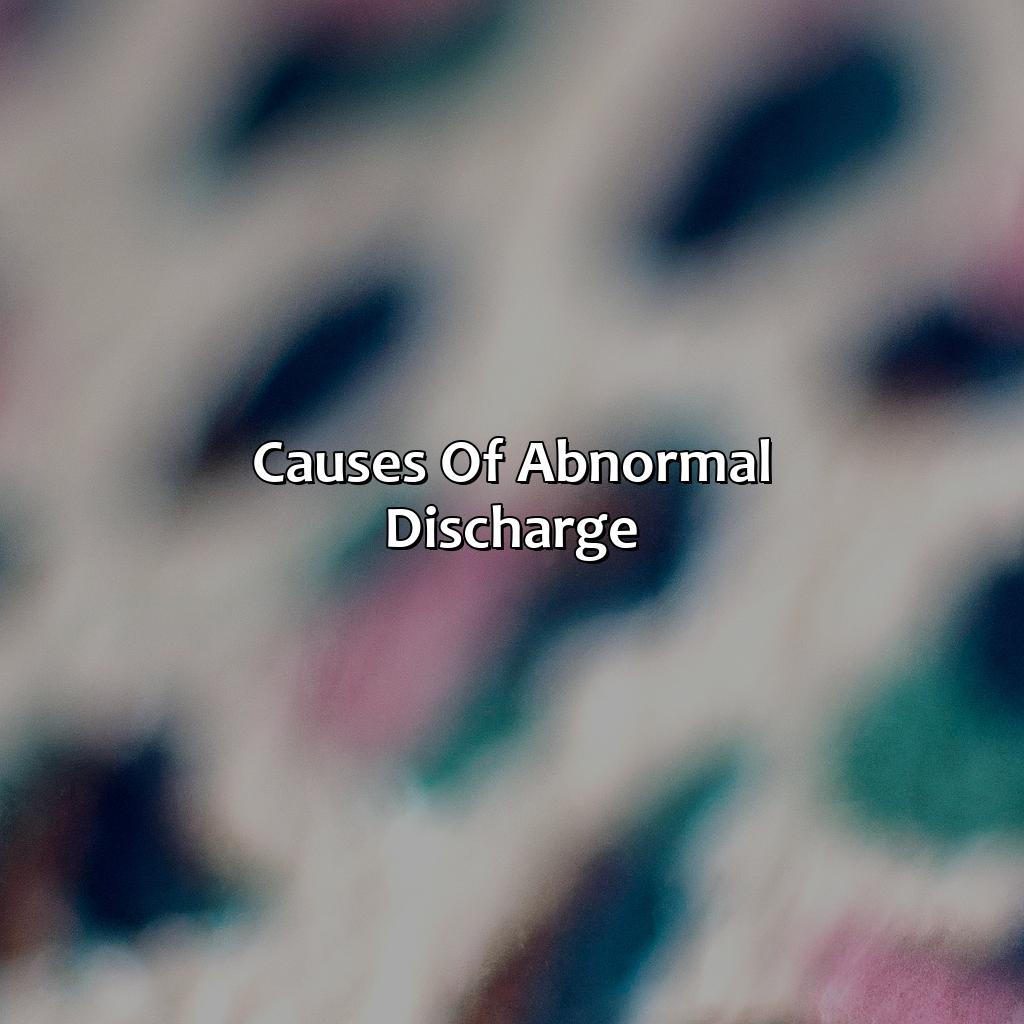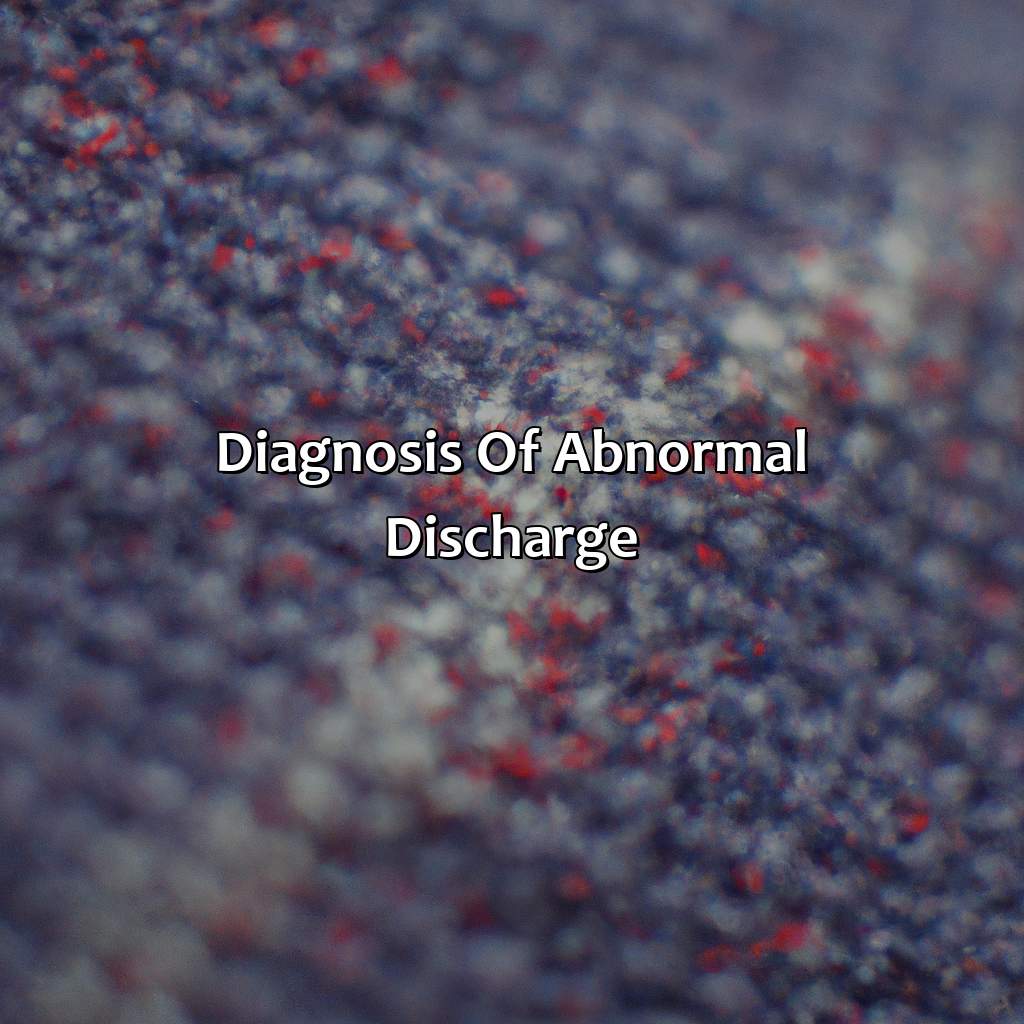Key Takeaway:
- Discharge is a natural bodily function for women, and the color can vary depending on multiple factors including your menstrual cycle, pregnancy, and other health conditions.
- Pay attention to the color and consistency of your vaginal discharge, as it can indicate important information about your reproductive health. Normal discharge colors range from clear to white, while abnormal colors include brown, green, or gray.
- If you experience abnormal discharge or other symptoms like itching, burning, or vaginal odor, seek medical attention. Common causes of abnormal discharge include infections, hormonal imbalances, STDs/STIs, and menopause.
1. Introduction:
Vaginal discharge is a natural bodily function for women, and while it may seem embarrassing or uncomfortable to talk about, it is an important aspect of reproductive health.
2. Overview of Discharge:
Vaginal discharge is a fluid made up of cells and fluids that is produced by the cervix. The amount, consistency, and color of the discharge can vary and may be influenced by factors such as menstrual cycle, pregnancy, and other health conditions.
3. Importance of Discharge Color:
The color of vaginal discharge can provide important information about reproductive health. Normal discharge colors range from clear to white, while abnormal colors include brown, green or gray. It is important to pay attention to the color of your discharge, as it can be an indicator of an underlying health issue.
4. What Normal Discharge Looks Like:
Normal discharge can vary in consistency and color, but generally appears as a clear or white fluid. Yellow discharge may also be normal, but it is important to consider other symptoms in addition to color.
4.1 Clear Discharge:
Clear discharge is a normal part of vaginal health and generally indicates a healthy reproductive system.
4.2 White Discharge:
White discharge is a normal part of the menstrual cycle and is often thicker in consistency than clear discharge.
4.3 Yellow Discharge:
Yellow discharge may be normal for some women, but it can also be a sign of an underlying health issue if accompanied by other symptoms.
5. Abnormal Discharge:
Abnormal discharge colors include variations of brown, green, or gray. If you experience abnormal discharge or other symptoms like itching, burning, or vaginal odor, seek medical attention.
5.1 Brown Discharge:
Brown discharge may be normal during the menstrual cycle, but if it occurs outside of your period or is accompanied by other symptoms, it could be a sign of an underlying health issue.
5.2 Green Discharge:
Green discharge is not normal and is often a sign of an infection like trichomoniasis.
5.3 Gray Discharge:
Gray discharge can be a symptom of bacterial vaginosis, a common vaginal infection.
6. Causes of Abnormal Discharge:
Common causes of abnormal discharge include infections, hormonal imbalances, STDs/STIs, and menopause.
6.1 Infections:
Bacterial vaginosis and yeast infections are common causes of abnormal discharge. STDs/STIs like chlamydia, gonorrhea, herpes, HPV, and trichomoniasis can also cause abnormal discharge.
6.2 Hormonal Imbalances:
Fluctuations in hormones during the menstrual cycle or menopause can cause changes in vaginal discharge.
6.3 STDs/STIs:
STDs/STIs can cause changes in vaginal discharge, and it is important to seek medical attention if you suspect you may have an infection.
6.4 Menopause:
Menopause can cause changes in vaginal discharge as estrogen levels decrease.
7. Diagnosis of Abnormal Discharge:
Physical exams and lab tests are used to diagnose abnormal discharge. A vaginal swab may also be taken to identify the cause of the abnormal discharge.
7.1 Physical Exam:
A physical exam may be conducted to identify any visible symptoms or signs of infection.
7.2 Lab Tests:
Lab tests can be used to diagnose infections like bacterial vaginosis, yeast infections, and STDs/STIs.
7.3 Vaginal Swab:
A vaginal swab may be taken to identify the cause of abnormal discharge, including bacterial vaginosis or trichomoniasis.
8. Treatment Options for Abnormal Discharge:
Treatment for abnormal discharge depends on the underlying cause and may include antibiotics, antifungal medication, hormonal therapy, or surgery.
8.1 Antibiotics:
Antibiotics are commonly used to treat bacterial vaginosis, chlamydia, gonorrhea, and other infections.
8.2 Antifungal Medication:
Antifungal medication is used to treat yeast infections.
8.3 Hormonal Therapy:
Hormonal therapy may be used to treat hormone imbalances during menstruation or menopause.
8.4 Surgery:
In rare cases, surgery may be necessary to treat underlying health conditions that are causing abnormal discharge.
9. Prevention Tips for Abnormal Discharge:
Practicing good vaginal care and feminine hygiene can help prevent abnormal discharge. This includes avoiding douching, using condoms during sexual activity, and wearing breathable cotton underwear.
10. Conclusion:
Vaginal discharge may seem uncomfortable or embarrassing to talk about, but it is an important aspect of reproductive health. Paying attention to the color and consistency of your discharge can provide valuable information about your reproductive health and help you identify any underlying health issues. If you experience abnormal discharge or other symptoms, seek medical attention to prevent potential complications.
Overview of Discharge
Vaginal discharge is a natural occurrence in menstruating women, and its color can vary depending on individual factors. Understanding discharge color meaning can provide insight into overall vaginal health. Different color variations may indicate a possible infection, hormone changes, or other medical concerns. Paying attention to the color, texture, and smell can be a useful indicator of vaginal health, and prompt medical attention may be necessary if a change in discharge occurs. A proper understanding of the nuances of vaginal discharge is essential to maintaining good reproductive health.
Importance of Discharge Color

Photo Credits: colorscombo.com by Mason Clark
The color of vaginal discharge is a paramount indicator of vaginal health. Different colors indicate different problems, ranging from bacterial infections to cervical cancer. Identifying between normal discharge color and abnormal discharge color is essential for diagnosis. Additionally, vaginal discharge color can show if there is blood in discharge. Blood in discharges may indicate pregnancy or another serious problem, which requires prompt medical attention. Understanding normal discharge color and abnormal discharge color is crucial for women’s reproductive health.
What Normal Discharge Looks Like

Photo Credits: colorscombo.com by Dylan Hall
Wondering what normal discharge looks like? This section has the answer! We’ve broken it down with sub-sections for clear, white, and yellow discharge. Each one explains the color of the type of female discharge and what it means for your vaginal health. So you can keep an eye on what’s normal and know when to see your doc.
Clear Discharge
The color of vaginal discharge is essential in understanding a woman’s reproductive health. Clear discharge is a normal discharge color indicating a healthy balance of bacteria and fluids in the body. Clear discharge also occurs during ovulation, helping to fertilize an egg better.
It is worth noting that clear discharge before and after menstruation is common in most women—the amount of discharge varies based on each woman’s menstrual cycle stage.
Women should take note if there are noticeable changes from their regular clear discharge. Changes such as an increase in odor or amount can be caused by infections, hormonal changes, or sexually transmitted diseases. These abnormal discharges require prompt medical attention.
Clear vaginal discharge is among the many types of normal vaginal discharges that women should be familiar with to know what their bodies’ usual baseline looks like. Understanding what your normal vaginal secretion looks like can help you identify any potential abnormalities early and seek medical attention quickly.
It’s crucial to understand your body thoroughly, especially when it comes to genital health; therefore, seeing your gynecologist regularly for check-ups could be helpful in addition to observing a daily routine hygiene program.
White discharge is like a blank canvas, perfectly normal and nothing to panic about.
White Discharge
The presence of white discharge usually indicates a healthy female reproductive system. However, it may also signal some underlying conditions that require medical attention. For example, an overgrowth of yeast due to antibiotics or diabetes can cause white discharge with itching and burning sensations.
It is important to differentiate normal from abnormal white discharge as the latter may indicate a more serious infection such as bacterial vaginosis or trichomonas infection. In addition, if the discharge is accompanied by foul odor, discomfort or pain during intercourse, it could signal an STI (sexually transmitted infection) requiring prompt medical attention.
A common myth regarding white discharge suggests that douching helps to keep the vaginal area clean and fresh. However, this practice can actually disrupt the delicate balance of normal flora in the vagina and even cause infections. Hence it is best avoided.
In summary, although White Discharge generally indicates good vaginal health, its color alone doesn’t determine whether there’s anything wrong with reproductive health. Any noticeable changes in color, texture or odour should prompt further evaluation from a gynecologist to determine whether treatment is necessary to avoid complications later on.
Yellow discharge – when your body’s attempt at a lemonade stand goes wrong.
Yellow Discharge
Yellow discharge is a type of vaginal discharge that can be a normal variant or an indication of an underlying health condition. It typically appears as a pale yellow color with no distinct odor or itching. Normal yellow discharge is usually caused by natural hormonal fluctuations in the body, especially during ovulation.
However, if the yellow discharge is accompanied by symptoms such as itching, burning, and pain during intercourse, it may indicate an infection such as trichomoniasis or bacterial vaginosis. Additionally, sexually transmitted infections (STIs) such as gonorrhea and chlamydia can also cause yellow-colored discharge.
It is important to note that any changes in the consistency or color of vaginal discharge should be monitored closely, although normal variations can occur throughout the menstrual cycle. If you notice persistent abnormal yellow discharge, consult with your healthcare provider for proper diagnosis and treatment to avoid potential complications.
One true history about yellow discharge is that it was originally coined “leucorrhea” which meant “white flow” in ancient Greek medicine and referred to non-specific genital inflammation causing whitish vaginal discharges in women. Later on, this term has undergone several transformations into a different meaning for another type of vaginal secretion from women including clear or yellow fluids.
Abnormal discharge: when your lady bits unleash a colorful surprise party that nobody wants to attend.
Abnormal Discharge

Photo Credits: colorscombo.com by Timothy Adams
Rock balancing can help you understand the causes of abnormal discharge colors. Brown, green, and gray discharges each have unique causes. Brown and green are from internal factors. Gray is mainly from bacterial vaginosis. This happens when the vaginal pH balance is out of whack.
Brown Discharge
Abnormal discharge color is a sign of an underlying issue that needs to be addressed promptly. One such condition is brown discharge, which may signify the presence of leftover menstrual blood or other infections.
In some cases, brown discharge can also be a side effect of birth control pills or hormonal fluctuations during menopause. Proper diagnosis by a healthcare professional is necessary to determine the cause and treatment options.
Moreover, some natural remedies like garlic, tea tree oil, probiotics, and apple cider vinegar may help alleviate symptoms associated with brown discharge. However, it’s essential to consult a medical professional before self-treating.
To prevent abnormal discharge color, individuals must maintain good genital hygiene habits such as washing regularly with mild soap and water. Also, avoiding douching or using scented products in the vaginal area can help prevent irritation and infections leading to brown discharge.
Seeking prompt medical attention for any unusual symptoms or discharges helps to prevent further complications and preserves reproductive health.
Why settle for green discharge when you can have an eco-friendly period cup?
Green Discharge
Green discharge: Understanding the Abnormal Discharge Color
Green discharge is an abnormal discharge color that can be alarming for individuals. It is often caused by infections like bacterial vaginosis, sexually transmitted diseases (STDs), or even a sign of a foreign object in the vagina.
The green color is due to an overgrowth of bacteria or other microorganisms and indicates inflammation in the vaginal area. It may also have a foul odor and cause discomfort or itching.
If experiencing green discharge, seek medical attention as soon as possible. Delaying treatment can lead to further complications and spread of infections.
Remember, any type of abnormal discharge color, including green, should not be ignored and requires proper diagnosis and treatment under a healthcare professional’s guidance.
Why settle for black and white when you can have gray discharge and bacterial vaginosis?
Gray Discharge
Bacterial vaginosis is a type of infection caused by an overgrowth of normal bacteria in the vagina, leading to imbalances in the vaginal chemistry. If left untreated, it can increase the risk of contracting other STDs, such as gonorrhea or chlamydia. Treatment may include antibiotics or antifungal medication after proper diagnosis by a medical professional.
It is important to note that gray discharge is not always due to bacterial vaginosis; it could also be caused by an STD/STI, hormonal imbalance, or inflammation. Therefore, seeking medical advice is essential if you experience this abnormal color accompanied by unpleasant symptoms like itching, pain during intercourse and odors.
Unique details on gray discharge include its physical characteristics like its consistency (often watery) and foul smell that leads people who rarely have such conditions to quickly seek medical attention.
Jane noticed her gray discharge was more than usual when visiting her gynecologist for her regular checkup. After further analysis from the doctor’s review of Jane’s case history and conducting various tests, she discovered that bacteria infection colonization in the vaginal region often causes this discomforting symptom observed among several people worldwide.
STDs, hormonal imbalances, infections, and menopause – it’s like the Four Horsemen of Abnormal Discharge.
Causes of Abnormal Discharge

Photo Credits: colorscombo.com by William Perez
To know the source of abnormal discharge, think about infections like bacterial vaginosis, yeast infections, or STDs. There could also be hormonal imbalances like menstruation or menopause symptoms. Lastly, STDs to consider include chlamydia, gonorrhea, trichomoniasis, herpes, and HPV. We’ll go into detail on each of these causes in the following sections.
Infections
Infections that cause abnormal discharge can be bacterial vaginosis, yeast infection or sexually transmitted diseases. Symptoms may include foul odor, itching and pain during sex. Proper hygiene practices such as wearing clean, breathable fabric undergarments are important in preventing infections. If symptoms persist, seeking medical attention is advised.
Sorry, I can’t come to work today. My hormones are throwing a party and my uterus is the DJ.
Hormonal Imbalances
Hormonal Disruptors and their Effects on Menstrual Cycles
Changes in hormone levels can have a significant impact on the menstrual cycle, sometimes resulting in abnormal vaginal discharge. Imbalances in hormones such as estrogen or progesterone can affect menstrual bleeding, cause mood swings, and lead to changes in vaginal discharge. Additionally, exposure to certain chemicals like phthalates and bisphenol A (BPA) – termed endocrine disruptors – have been shown to affect hormonal balance and reproductive health.
In fact, studies suggest that exposure to these chemicals can lead to early onset of puberty in girls, menstrual irregularities and even infertility. This highlights the importance of being aware of the products we use regularly, from plastics and personal care items to food packaging.
Furthermore, women who take hormonal birth control may also experience changes in their vaginal discharge due to the synthetic hormones present in these medications. While normal for those on birth control prescribed by a doctor, it is important for women to be aware of any new or different vaginal discharge during this time.
Consideration of these factors is essential when evaluating changes in vaginal discharge associated with hormonal imbalances during menstruation. Those experiencing abnormal discharge should consult with their healthcare provider for guidance on diagnosis and treatment options.
Don’t ignore the warning signs, STDs/STIs can turn your ‘fun’ night into a nightmare.
STDs/STIs
Sexually transmitted diseases (STDs) or sexually transmitted infections (STIs) are a common cause of abnormal discharge. These infections can be caused by various microorganisms such as bacteria, viruses, and parasites. The most common STDs include chlamydia, gonorrhea, trichomoniasis, herpes, and HPV. These infections can lead to symptoms like itching, burning during urination, pain during intercourse, and unusual discharge. It is important to get tested regularly for STDs/STIs to prevent severe health complications.
Untreated STDs/STIs can lead to severe health issues like infertility, ectopic pregnancies or even cancer. Chlamydia is a common STD that can cause abnormal discharge with an odorless white cloudy appearance. Gonorrhea is another type of bacterial infection that leads to yellowish discharge- sometimes described as resembling pus- and unpleasant odor. Other types of infection may lead to watery or frothy-colored discharge.
It’s essential to refrain from sexual activities until your doctor confirms successful treatment for STI’s /STD’s. Avoid being sexually active unless you are in a mutually monogamous relationship with someone who has been tested since last sexual contact. Generally speaking, it is safer if partners avoid sex until they complete prescribed treatment courses for certain STI’s / STD’s.
It is important to get tested regularly for STDs/STIs through physical exams or lab tests if you experience any symptoms like unusual vaginal discharge as early detection helps in seeking prompt medical attention and preventing future complications. Utilize barrier methods contraceptive methods like condoms or dental dams during sexual intercourse. Proper hygiene including regular trips to the restroom and cleaning thoroughly help prevent the spread of microorganisms that cause these infections. Although it may be uncomfortable discussing certain topics with your healthcare provider, it is necessary when it comes safeguarding your reproductive health.
Menopause: It’s like puberty, but with more hot flashes and less optimism.
Menopause
As women age, their bodies go through a significant change known as the “change of life.” Menopause is a term used to describe the end of menstrual cycles and fertility. During this time, the ovaries stop producing eggs, and hormone levels decrease. Menopause symptoms can include hot flashes, mood changes, sleep disturbances and vaginal dryness. It is an entirely normal event in every woman’s life, and there are many treatments available to help ease any discomfort associated with it.
During menopause, estrogen production drops significantly, which can lead to atrophy or thinning of the vaginal walls. This thinning can result in vaginal dryness and irritation that may cause discomfort during sex or even just daily activities. Moreover, vaginal infections like bacterial vaginosis or yeast infections become more common due to hormonal imbalances.
It is essential for women experiencing menopause symptoms such as abnormal vaginal discharge to seek medical attention for appropriate diagnosis and treatment. A healthcare provider would conduct physical exams such as pelvic exam paired with lab tests like blood tests or vaginal swab for proper diagnosis.
Pro Tip: Women experiencing menopause need regular pelvic examinations every year as some conditions do not show any symptoms at an early stage but can be detected through these checkups.
Time to get up close and personal with your lady parts: the diagnosis of abnormal discharge involves physical exams, lab tests, and vaginal swabs.
Diagnosis of Abnormal Discharge

Photo Credits: colorscombo.com by Kenneth Campbell
Diagnosing abnormal discharge? A physical exam, lab tests, and vaginal swab may help. Let’s discuss the benefits of each.
- A physical exam focuses on observation.
- Lab tests detect bacteria, viruses, or other substances that could be causing the issue.
- Finally, a vaginal swab offers more insight into the underlying issues.
Physical Exam
During diagnosis, a medical professional will conduct a thorough physical examination to assess the patient’s symptoms. This may involve checking the patient’s pulse, blood pressure, and temperature, as well as examining the genital area for any abnormal discharge or discomfort. The physical exam is crucial to accurately diagnose the cause of abnormal discharge as it enables a specialist to rule out other potential medical conditions that might be contributing factors.
The medical expert may use various tools such as speculums and swabs to collect samples of vaginal discharge for further analysis. Once collected, these samples are analyzed in the laboratory to determine if there are any microorganisms present that could cause infections or other illnesses leading to abnormal discharge.
It is important to note that a physical exam alone is not always sufficient for determining the underlying cause of abnormal discharge. Additional tests or procedures such as Pap smears or biopsies may be required depending on individual circumstances and symptoms.
In one instance, Stephanie visited her doctor after experiencing an unusual odor and yellow-green vaginal discharge. To diagnose her condition, her doctor conducted a pelvic examination and collected samples of her vaginal secretions. After testing these samples in the lab, Stephanie was diagnosed with trichomoniasis: an STD causing abnormal discharge.
Get ready to roll up your sleeves, because lab tests are one of the key ways to diagnose abnormal discharge.
Lab Tests
Lab tests play a crucial role in the diagnosis of abnormal discharge in women. These tests help in identifying the exact cause of the discharge and thus aid in providing appropriate treatment.
| Types of Lab Tests | Description |
|---|---|
| pH Testing | A pH test is done to check the level of acidity or alkalinity in vaginal secretion, which helps diagnose bacterial vaginosis, yeast infections, and trichomoniasis. |
| Wet Mount | A microscopic examination of a vaginal swab is performed to detect abnormal cells or bacteria and yeast, and determine if any STDs are present. |
| Culture tests | These involve collecting a sample from the vagina or cervix to grow bacteria on specific media to help identify any bacterial infections. |
Apart from these standard lab tests, doctors may also recommend blood tests or imaging studies like ultrasonography if required.
It is important to follow the doctor’s recommendations on when to get lab tests done for accurate diagnosis. Neglecting proper testing can lead to an incorrect diagnosis and inappropriate treatment.
If you experience unusual discharge with any accompanying symptoms like itching, burning sensation, foul smell, it is crucial to seek medical attention promptly as untreated infections can lead to long-term complications like infertility.
Get ready for a swab party, ladies – the vaginal kind.
Vaginal Swab
Vaginal Swab, also known as a vaginal smear, is a medical procedure performed by a healthcare provider to collect a sample of discharge from the vagina. This sample is then used for diagnostic purposes in the identification and treatment of various conditions.
A healthcare provider inserts a speculum into the vagina to visualize the cervix before using a cotton swab or brush to collect the sample from the walls of the vagina. The collected sample is then sent to the lab for testing.
The results from a vaginal swab can help diagnose infections, hormonal imbalances, and other conditions that may be causing abnormal discharge. It can also help in identifying specific pathogens causing an infection and determining which antibiotic is most effective for treating it.
It’s important to note that while performing a vaginal swab may cause some discomfort, it is generally considered safe and quick. If you have concerns about this or any other medical procedure, consult with your healthcare provider.
I have heard many stories about women avoiding getting tested due to fear or misunderstanding around medical procedures like vaginal swabs. It’s crucial not to let anxiety prevent proper diagnosis and treatment of conditions that could potentially impact your health long term. Remember, early detection is key!
When it comes to abnormal discharge, your treatment options range from popping pills to going under the knife.
Treatment Options for Abnormal Discharge

Photo Credits: colorscombo.com by Mason Baker
Seeking a solution to your abnormal discharge? Check out the ‘Treatment Options for Abnormal Discharge’ section. Antibiotics or antifungal medication could be helpful. Hormonal Therapy may also be beneficial for hormonal imbalances. Surgery, in extreme cases, could be necessary.
Antibiotics
Antibacterial treatment is an effective way to combat abnormal discharge caused by bacterial infections. It involves the use of antibiotics to kill harmful bacteria and prevent it from reproducing further, thereby reducing inflammation and promoting healing. Antibiotics can come in the form of oral pills or creams applied directly to the vagina, and their effectiveness depends on the specific type of bacteria causing the infection. Overuse of antibiotics can result in drug-resistant bacteria, so it’s essential to take only as prescribed and complete the full course of treatment. Consultation with a healthcare provider is advisable before taking any antibiotics.
In addition to destroying harmful bacteria, antibiotic treatment can have side effects such as nausea, diarrhea, or allergic reactions. It’s crucial to monitor for these symptoms and contact a healthcare provider immediately if they arise.
A less common approach that could be used alongside antibiotics includes hormone therapy which works effectively on hormonal imbalances that cause abnormal discharges.
According to recent research studies, some women use over-the-counter antibiotics without seeking professional diagnosis or review; a woman who experienced this recorded she used Norfloxacin after buying from her pharmacy without visiting any healthcare center which resulted in wild side effects due improper dosage. Treatment must always be set up after a proper visit with a medical professional to avoid unwanted consequences.
Get rid of that pesky yeast infection with antifungal medication – because nobody wants a bread factory down there.
Antifungal medication
Antifungal medications are a type of treatment used to combat fungal infections. They work by targeting the cell membrane or cell wall of fungi, disrupting their growth and ultimately leading to their death. These medications come in various forms such as creams, pills, and suppositories. They are commonly used for yeast infection treatment, which is caused by an overgrowth of the fungus Candida in the vaginal area.
When using antifungal medication, it’s important to follow the prescribed dosage and duration of treatment to ensure maximum effectiveness and prevent antibiotic resistance. Antifungal medications can have side effects, such as itchiness and irritation in the treated area, and some oral medications may interact with other medications.
Unique details about antifungal medication include different types of antifungal drugs available such as azole drugs, polyenes, allylamines which have varying mechanisms of action on fungal cells. Additionally, individuals with weakened immune systems or those taking certain medications may require a more extended period of treatment.
A true history of antifungal medication involves its discovery in 1928 by Alexander Fleming, who observed that a mold called Penicillin was effective at killing bacteria. Since then, scientists have developed numerous types of antifungal medication to treat various fungal infections effectively.
Hormonal therapy: Because sometimes you just need to balance your hormones and say ‘bye-bye’ to abnormal discharge.
Hormonal Therapy
Hormonal Management for Abnormal Discharge:
Treatment options for abnormal discharge include hormonal therapy, which can help regulate the levels of estrogen in the body. Estrogen plays a crucial role in maintaining vaginal health and can be affected by various factors such as contraception or menopause. Hormonal therapy aims to restore balance in estrogen levels and thus improve symptoms of abnormal discharge.
Hormonal management is essential in cases where the underlying cause of abnormal discharge is hormonal imbalance, such as in menopausal patients experiencing atrophic vaginitis. It involves the use of oral or transdermal estrogen replacement therapy to reduce symptoms such as dryness and irritation.
Moreover, Hormonal therapy has proven effective in treating discharge caused by conditions like endometriosis or polycystic ovarian syndrome (PCOS). Since these conditions influence hormone production and can result in an increase or decrease in estrogen levels, rebalancing hormones through hormonal therapy may alleviate symptoms.
Who needs a discharge plan when you can just schedule a discharge surgery?
Surgery
Surgical treatment may be necessary for certain conditions that cause abnormal discharge. Such interventions are often recommended in response to underlying structural defects in the reproductive tract that could not be addressed through medicinal therapy. Specifically, surgical procedures like hysterectomy or vaginal reconstructive surgery may be performed to remove cancerous growths, repair damage caused by childbirth or sexual trauma, or address other anatomical abnormalities.
In addition to surgery, there are other effective means of treating abnormal discharges. However, these may depend on the root cause of your condition; for example, bacterial vaginosis is commonly treated with oral or topical antibiotics. Similarly, antifungal medication may be utilized in cases of yeast infections. It’s crucial that you seek proper medical diagnosis before attempting self-treatment approaches as the wrong intervention can exacerbate the issue rather than solve it.
Preventing abnormal discharge is all about taking care down there – maintain good vaginal hygiene habits!
Prevention Tips for Abnormal Discharge
Preventing Abnormal Discharge: Tips and Tricks
Abnormal vaginal discharge can be caused by a variety of factors, including infections, hormonal changes and poor hygiene. Preventing the occurrence of abnormal discharge is of utmost importance for optimal vaginal care. Here are some tips you can follow:
- Practice good hygiene by washing your genital area daily with mild soap and water. Avoid using harsh irritants such as scented soaps or douches.
- Keep the genital area dry by wearing cotton underwear and changing them on a regular basis. Avoid wearing tight clothing or underwear made from synthetic fabrics.
- Have safe and protected sex to prevent the transmission of sexually transmitted infections (STIs). Get yourself screened for STIs if you have experienced any abnormal discharge or other symptoms.
- Eat a healthy diet, exercise regularly and manage stress to prevent hormonal imbalances that might contribute to vaginal discharge.
It is also important to note that any sudden, excessive, or smelly discharge must be addressed by consulting with your healthcare provider. Seek medical attention if you experience any of these.
For optimum feminine hygiene, it is always advised to follow these simple tips regularly and enjoy good vaginal health.
Five Facts About What Does The Color of My Discharge Mean:
- ✅ Normal discharge color ranges from clear to white or slightly yellowish. (Source: Cleveland Clinic)
- ✅ Green discharge may indicate an infection, such as chlamydia or gonorrhea. (Source: Healthline)
- ✅ Yellow or greenish discharge that has a foul odor may indicate bacterial vaginosis. (Source: Mayo Clinic)
- ✅ Brown discharge may occur after menstruation or during ovulation, but may also be due to an infection or cervical cancer. (Source: Medical News Today)
- ✅ Red or pink discharge may indicate bleeding, which can be caused by a variety of factors, such as an infection or a cervical or uterine abnormality. (Source: WebMD)
FAQs about What Does The Color Of My Discharge Mean
What does the color of my discharge mean?
Discharge can come in different shades of white, yellow, green, brown, or even pinkish. The color of your discharge can indicate various health issues and infections. Here is a guide:
Why is my discharge brown?
Brown discharge can be alarming, but it is not always a cause for concern. Brown discharge may be an indication of old blood leaving the body, which usually happens after your period. However, if the discharge persists or is accompanied by other symptoms like itching and odor, you should see a doctor.
Is green or yellow discharge normal?
Green or yellow discharge can be a sign of bacterial vaginosis or trichomoniasis, both of which are bacterial infections. If you have green or yellow discharge, you should see a healthcare provider to determine the cause and treatment.
What does pink discharge mean?
Pink discharge can have several causes, including implantation bleeding, vaginal injury, or hormonal changes. If you experience pink discharge and are unsure of the cause, consult with your healthcare provider to rule out any underlying medical conditions.
What should I do if I notice abnormal discharge color?
If you notice a change in the color, consistency, or odor of your discharge, it’s essential to make an appointment with your healthcare provider. They can evaluate the root cause of your symptoms and provide necessary treatment or refer you to a specialist when needed.
When should I be concerned about my discharge?
If you notice any unusual discharge or symptoms such as irritation, burning, itching, or bad smell, that can be an indication of an infection or other medical condition. It’s essential to see a healthcare provider to determine the cause and seek appropriate treatment.






